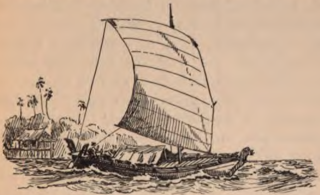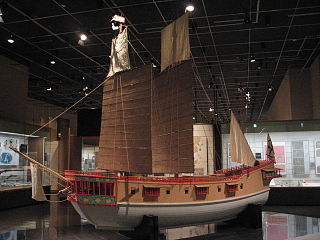 W
WBagan or bagang is a fishing instrument that uses nets and lights so that it can be used for light fishing, originating from Indonesia. Bagan is floated out to the sea to catch fishes, squids, and shrimps, and remain in the sea for several days or even months. The catch would be transported to land using other boats.
 W
WA bago is a traditional boat built by the Mandar people of Sulawesi, Indonesia. The hull is of the pajala-type, lightly built and allowing for shallow displacement. The boat is long, with the mast only making up a quarter of its length. A bago can be readily identified as Mandarese boat by its rudderpost style. Smaller-sized bagos are often used as fishing boats from which fishermen cast their nets. The Mandar people prefer using a bago over an outrigger canoe.
 W
WBinabina or biabina is a type of plank boat from the Solomon Islands. It differs from the similar tomako and lisi in that only the stern is upturned, while the bow is horizontal.
 W
WThe djong, jong, or jung is a type of ancient sailing ship originating from Java that was widely used by Javanese and Malay sailors. The word was and is spelled jong in its languages of origin, the "djong" spelling being the colonial Dutch romanisation.
 W
WJellore is a traditional Sumatran sailing craft. These boats are long and narrow, and fitted with double outriggers that stands out considerable distance from the sides. Sometimes they only have one outrigger, which is alternately set in windward and leeward. These boats are rigged with tanja rig. When the sail is partly furled, the ends of the two booms curve downwardly and inserted into the floats of the outrigger.
 W
WA junk is a type of Chinese sailing ship with fully battened sails. There are two types of junk in China: Northern junk, which is developed from Chinese river boats, and southern junk which is developed from Austronesian ship designs, examples of which have been trading with the Eastern Han dynasty since the 2nd century AD. They continued to evolve in the later dynasties, and were predominantly used by Chinese traders throughout Southeast Asia. They were found, and in lesser numbers are still found, throughout Southeast Asia and India, but primarily in China. Found more broadly today is a growing number of modern recreational junk-rigged sailboats. Chinese junks referred to many types of coastal or river ships. They were usually cargo ships, pleasure boats, or houseboats. Historically they have ranged in size from small river and coastal vessels to large ocean going ships, and there are significant regional variations in the type of rig, however they all employ fully battened sails.
 W
WKakap is a narrow river or coastal boat used for fishing in Malaysia, Indonesia, and Brunei. They are also sometimes used as auxiliary vessels to larger warships for piracy and coastal raids.
 W
WThe term lambo or lamba refer to two types of traditional boats from Indonesia.
 W
WLanong were large outrigger warships used by the Iranun and the Banguingui people of the Philippines. They could reach up to 30 m (98 ft) in length and had two biped shear masts which doubled as boarding ladders. They also had one to three banks of oars rowed by galley slaves. They were specialized for naval battles. They were prominently used for piracy and slave raids from the mid-18th century to the early 19th century in most of Southeast Asia. The name lanong is derived from Lanun, an exonym of the Iranun people.
 W
WLepa-lepa is a traditional canoe from the eastern part of the Indonesian archipelago. They are short range coastal fishing craft, but they can also be used for inter island voyages. The routes they took, among others are between Seram and Ambon-Lease, Geser island and Seram Laut, within Banda and Kei group of islands. They are already existed since at least 1500 A.D.
 W
WLonde or londi is a traditional boat from North Sulawesi, Indonesia. They are thought to have existed since 1500s, developed from ancient Sangir islands boat called bininta which is now enshrined in the symbol of the region of Sangir Islands District.
 W
WPerahu Mayang or simply mayang is a type of fishing boat from Java, Indonesia. This type of boat is used mainly for fishing and trading. Historically, this indigenous vessel is also favored by European skippers and private merchants for trading in East Indies: 50% of them were using mayang and pencalang. It is mostly used in northern coast of Java. The major production site is in Rembang, Central Java.
 W
WOrembai or Arombai is a type of plank boat from the Maluku Islands of Eastern Indonesia. It is mainly used for fishing and transport. This vessel is used as far as Batavia, where in the 17th century it became popular to go out "orembaaien" on an evening rowing on the river or city canals.
 W
WPajala is a type of traditional perahu from western South Sulawesi, Indonesia. It is used mainly for fishing, but in the present it's a Bugis/Makassar name for small to medium-sized boat hull.
 W
WPatorani is a traditional fishing boat from Makassar, Indonesia. It is used by Macassan people for fishing, transport, and trading since at least 17th century A.D. Historically this type of boat was used by Gowa Sultanate as war boat.
 W
WPelang or pilang is a traditional boat from Indonesia and Malaysia. It may refer to several different type of boats in the Nusantara, but commonly they refer to outrigger canoe. The function differs from where they were used, from transporting people, fishing, to trading. Pilang has been known from at least the 14th century.
 W
WPerahu payang or simply payang is a traditional Malay open fishing boat. They are usually found in Terengganu, and to a lesser extent, Kelantan, Pahang, and Johor coasts. A few examples normally come down to Singapore to operate during the period of the north-east monsoon in the South China Sea.
 W
WRed-seal ships were Japanese armed merchant sailing ships bound for Southeast Asian ports with red-sealed letters patent issued by the early Tokugawa shogunate in the first half of the 17th century. Between 1600 and 1635, more than 350 Japanese ships went overseas under this permit system.
 W
WA Sandeq is a type of outrigger sailboat or trimaran used by the Mandarese people for fishing and as a means of transportation between islands. The size of Sandeq varies, with hulls ranging from 5 to 15 metres long and 0.5 to 1.5 metres wide. Its carrying capacity ranges from a few hundred kilograms to over 2 tons. The sleek shape of the Sandeq makes it more agile and faster than other sailboats. The name of the vessel comes from a word in the Mandar language that means pointy, referring to the bow's shape.
 W
WSolu is a traditional boat of Toba Batak people of North Sumatra, Indonesia. Solu is a dugout canoe, with boards added on the side bound with iron tacks. They are of various size, the largest, for 50 rowers, are about 18 meters in length; there is a slight keel carved fore and aft. They are propelled by sitting rowers, who sit in pairs on cross seats. The paddles used have an oval blade and cross handle. The boat can be distinguished by its ornaments: The stern ornament is called giarogia di pudi, which consists of three sticks with tufts of horsehair and a row of shorter sticks called rame rame with a bigger one in the middle distinctly phalloid, strung across; no tradition appears to explain this singular ornament. The ornament on the prow is a carved and painted figure symbolising a buffalo head, with another rame rame strung in front with its singular central phallus. A sort of bowsprit with tufts of horsehair at the sides and one of human hair at the end, over it rises an upright carved post, called the torgiok.
 W
WTomako or tomoko is a large war canoe from the Solomon Islands. The name "tomako" is used in New Georgia in the Roviana language. It is also known as magoru in Marovo, niabara in Vella Lavella, mon in Bougainville, ora in Makira, and iola or ola in Malaita and Ulawa. Tomako were narrow and usually between 12 to 18 m in length. They did not possess outriggers or sails and were propelled solely by paddling. They were built by fitting planks edge-to-edge which are then "sewn" together and caulked with a paste made from the nut of the tree Parinarium laurinum. They could carry 30 to 50 warriors, and were used in raiding expeditions for slaves or for headhunting. They were characteristically crescent-shaped, with sharply upturned prows and sterns that were decorated with fringes of cowrie shells, nautilus shells, and mother-of-pearl, as well as intricate carvings. These carvings are usually of spirit animals or warriors like the kesoko and Tiolo. The body is commonly blackened to contrast with the decorations.